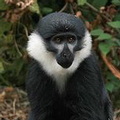 一處位於烏干達(Uganda)魯文佐里山脈(Rwenzori Mountains)的高海拔濕地區域在5月13日獲得國際注目,成為「國際重要濕地拉姆薩公約」(Ramsar Convention on Wetlands of International Importance)指定的保護區,這個保育決策可協助保護這個獨特的生態系,免於人口成長下各種需求的影響。
一處位於烏干達(Uganda)魯文佐里山脈(Rwenzori Mountains)的高海拔濕地區域在5月13日獲得國際注目,成為「國際重要濕地拉姆薩公約」(Ramsar Convention on Wetlands of International Importance)指定的保護區,這個保育決策可協助保護這個獨特的生態系,免於人口成長下各種需求的影響。
這個獨特的生態系已知存在將近2000年了。在西元第一世紀時,亞歷山大的(Alexandrine)地理學家托勒密(Claudius Ptolemy)指出尼羅河的源頭來自赤道區域的覆雪峰群,也稱為月球山脈(Mountains of the Moon,或稱「Lunis Montae」)。
位於西烏干達的魯文佐里山脈是非洲最高的山脈,有6座山峰覆有冰河。這個新的魯文佐里拉姆薩保護區面積涵蓋99,500公頃的山區,座落在一個國家公園也是聯合國教科文組織(UNESCO)世界遺產的區域範圍內。
這個新的拉姆薩保護區位於剛果民主共和國(Democratic Republic of Congo)的邊界,那塊區域的山群是維龍加國家公園(Virunga National Park)的一部份,這個國家公園被拉姆薩公約認可並指定為一處世界遺產。
烏干達水與環境部(Ministry of Water and Environment)濕地經營司(Wetlands Management Department)主管瑪琺比(Paul Mafabi)在格蘭第(Gland)舉行的第40屆拉姆薩常務委員會議(40th meeting of the Ramsar Standing Committee)中一個小型慶祝儀式的開幕式上,接過這個拉姆薩保護區的認證書,成為烏干達最新的國際重要濕地。
擔任烏干達拉姆薩保護區行政主管(Ramsar Administrative Authority)的瑪琺比表示:「魯文佐里山脈對這塊區域的生態學及水文學是非常重要的,尤其是它們提供水源給烏干達第一個拉姆薩保護區喬治湖(Lake George),這個湖是非洲擁有最高魚類多樣性的區域之一。」喬治湖在1988年被拉姆薩公約指定為保護區。
世界自然基金會國際總部(WWF International)的濕地保育經理蘭登柏克(Denis Landenbergue)表示:「烏干達的魯文佐里山脈和剛果民主共和國的維龍加國家公園結合起來,有潛力成為非洲第二個跨國境的國際重要濕地。」
世界自然基金會國際總部的淡水計畫案,從2000年起就一直支助烏干達的濕地保育。蘭登柏克指出,魯文佐里山脈長年受到氣候變遷的負面影響,拉姆薩保護區的指定對保育這座山脈具有很大的重要性。
根據泰勒博士(Dr. Richard Taylor)2006年發表的報告,這個區域海拔最高的冰河正快速融解中,被冰河覆蓋的區域從1906年第一次由阿布若季公爵(Duke of Abruzzi)調查到的6.5平方公里退縮至2003年的少於1平方公里。
魯文佐里山脈冰河的融失會進而影響較低海拔的濕地,而這些濕地供應水源給該區域的民眾及野生生物。
魯文佐里濕地沼澤維繫獨特動植物物種的生命。大象、猩猩及其他如深紅霓羚(Rwenzori duiker)等的瀕危物種(endangered species)棲息在這個區域裡。深紅霓羚是一種小型羚羊,學名叫做Cephalophus rubidus。
這些山脈已知供養21種小型哺乳動物,包括特有及族群脆弱的魯文佐里獺鼩(Rwenzori otter shrew,學名為Micropotamogale ruwenzorii)。
在此新的拉姆薩保護區發現且具有全球保育重要性的其他物種,還包括白腮猴(L'Hoest's monkey,學名為Cercopithecus lhoesti)、蹄鼻蝠(horseshoe bat)及羅氏太陽鳥(Rockefeller's sunbird,學名為Cinnyris rockefelleri)。這個保護區裡也發現一些本土性魚種。
A high altitude wetland area in Uganda's Rwenzori Mountains received international recognition on Wednesday as a protected site under the international Ramsar Convention on Wetlands of International Importance, a conservation decision that could help protect the unique ecosystem from the demands of a growing population.
This unusual ecosystem has been known for nearly 2,000 years. In the first century AD, the Alexandrine geographer Claudius Ptolemy suggested that the Nile River had its source from snow peaks on the Equator, the "Lunis Montae" or Mountains of the Moon.
The Rwenzori in western Uganda is the highest mountain range in Africa, with six glacial peaks. The new Rwenzori Ramsar Site covers 99,500 hectares of the mountainous region - it is located within a national park and UNESCO World Heritage Site.
The new Ramsar site borders the Democratic Republic of Congo, where the mountains are part of Virunga National Park - also designated under the Ramsar Convention and recognized as a World Heritage Site.
Paul Mafabi, commissioner of the Wetlands Management Department in Uganda's Ministry of Water and Environment, accepted the Ramsar site certificate for Uganda's newest Wetland of International Importance in a brief ceremony during the opening session of the 40th meeting of the Ramsar Standing Committee in Gland.
"The Rwenzori Mountains are very important for the ecology and the hydrology of the region; in particular, they supply water to Lake George, Uganda's first Ramsar Site, which has one of the highest fish diversity in Africa," said Mafabi, who serves as the Ramsar Administrative Authority in Uganda. Lake George was designated under the Ramsar Convention in 1988.
"Together, the Rwenzori Mountains in Uganda and the Virunga in the neighboring Democratic Republic of Congo offer the potential to become Africa's second transboundary Wetland of International Importance," said Denis Landenbergue, wetlands conservation manager at WWF International.
WWF International's Freshwater Program has been supporting wetlands conservation in Uganda since 2000.
Landenbergue says the Ramsar designation has major conservation significance for the Rwenzori Mountains, which for years have suffered because of climate change.
The region's high altitude glaciers are rapidly melting. The glaciated area has shrunk from 6.5 square kilometers in 1906, when it was first surveyed by the Duke of Abruzzi, to less than one square kilometer in 2003, according to a report published by Dr. Richard Taylor in 2006.
The loss of Rwenzori's glaciers in turn affects wetlands in the lower altitudes that supply water to the area's people and wildlife.
Rwenzori wetland bogs support unique species of plant and animal life. Elephants and chimpanzees inhabit the area along with other endangered species such as the small antelope called the Rwenzori duiker, Cephalophus rubidus.
The mountains are known to support 21 species of small mammals, including the endemic and vulnerable Rwenzori otter shrew, Micropotamogale ruwenzorii.
Other species of global conservation concern found in the new Ramsar site include L'Hoest's monkey, Cercopithecus lhoesti, the horseshoe bat, and Rockefeller's sunbird. Several indigenous fish species also are found within the site.
全文及圖片詳見:http://www.ens-newswire.com/ens/may2009/2009-05-13-03.asp




